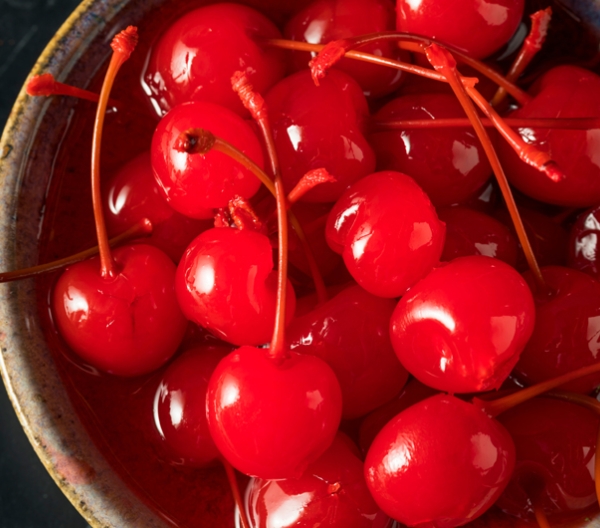Carcinogenic Red 3 is hiding in these Halloween candies

chudo2307 - stock.adobe.com.
We're not opposed to having a treat on Halloween—but the food dye Red 3 causes cancer, is in hundreds of candies, and should be avoided whenever possible. Here's what to look out for.
Where Red 3 lurks in your trick-or-treater’s candy bucket
Real talk: Everyone is aware that candy is not the healthiest choice. We’re not saying no one should ever have a treat; some candies—like peanut butter cups—have a bit of protein, and a little something sweet can be a bright spot on a chilly autumn evening. Spooky season is a fun one! But if you’re avoiding ingredients that even the FDA agrees are carcinogenic, then Red 3 should be at the top of your list.
What is Red 3?
Red 3, also labeled Red Dye No. 3 or FD&C Red 3, is a synthetic food coloring. Despite its FDA recognition as a carcinogen, Red 3 is lurking in hundreds of candies, cakes, and other foods. This includes dozens of seasonal Halloween items; and even in ostensibly healthy options, like fruit cocktails containing cherries. A search of Food Scores, a database maintained by the Environmental Working Group, generated 3,183 brand-name food products that contain Red 3—including hundreds of foods made by the country’s biggest food companies.
The synthetic food dye was banned from use in cosmetics and topical drugs way back in 1990, but thanks to some heavy lobbying from the maraschino cherry industry, FDA never followed up on banning it from use in food. That means Red 3 is a known carcinogen that’s used freely in the US food supply—and that’s been the case 33 years longer than necessary.
This past weekend, Gov. Gavin Newsom signed AB418, the California Food Safety Act, into law, meaning that (human) foods containing Red 3 and three other additives will no longer be legal to sell or distribute in the state beginning in 2027. CSPI and partners like the Environmental Working Group urged Gov. Newsom to sign the bill, and have petitioned the FDA to review and remove Red 3 from the US food supply. Meanwhile, similar legislation in New York, ABA6424, contains much of the same language as the original California bill, meaning that, if it passes, it would force manufacturers of candies and other foods that use titanium dioxide, Red 3, BVO, propylparaben, and potassium bromate to reformulate before selling their food products in the state.
While CSPI and our partner organizations work to eliminate Red 3 from all foods, the best thing consumers can do is be aware and avoid Red 3 when possible. To help you sort through your goodies this holiday season, we’ve rounded up a list of popular candy and snack items that might find their way into your home.
Candy corn
The classic corn-shaped Halloween candy made by Brach's contains Red 3—along with other food dyes of concern (Yellow 5 and Yellow 6). And it’s not the only member of the Brach’s candy family to watch out for: Around 100 Brach’s brand products contain Red 3, including some you might find only at Halloween, including the brand’s version of RedHots, Brach's Cinnamon Imperial Hard Candy, as well as Mellowcreme Flavored Pumpkins, Mini Candy Corn With Sea Salt & Chocolate Peanuts, Mellowcreme Autumn Mix, and Mellowcreme Caramel Apples.
While Nerds' seasonal candy-shelled Nerds Candy Corn is a relative newcomer to the Halloween game, it's not very different from Brach’s, according to the ingredients list. That’s not a huge surprise, though, as the same parent company—Ferrara Pan Candy Company—owns both brands, as well as RedHots, SweeTARTS, Lemonhead, and Now & Later candies. The original Nerds candy contains a whole slew of food dyes—different flavors vary, but most use some combination of Red 40, Blue 1, and Yellow 5, as well as the “lake” or oil-dispersible varieties of those colorings—but they don’t appear to contain Red 3.
Hot Tamales
While the original Hot Tamales candy contains several synthetic food dyes (Red 40, Yellow 5, Yellow 6, Blue 1), it doesn’t use Red 3. The culprit here is the brand’s Fire & Ice Chewy Cinnamon and Cool Mint mixed candies, which adds Red 3 to the list.
PEZ
All varieties of PEZ candies—regardless of the seasonality or movie- or TV-brandedtie-ins of the dispensers—contain Red 3, along with a full supporting cast of other food dyes of concern, including Yellow 5, Yellow 6, and Blue 2.
Sixlets
These tiny, candy-coated chocolate pellets seem only to appear at Halloween, which is probably for the best since they seem to contain nearly every common synthetic food coloring available to manufacturers, as well as Red 3. The ingredient list for Great Value’s Candy-Coated Chocolately Pearls, a similar product available year-round, is nearly identical but includes additional mica-based pigments. Both contain titanium dioxide, as well, which CSPI rates as “Avoid” because it potentially damages DNA.
Fruit by the Foot
Though these are less commonly handed out to trick-or-treaters than, say, mini Snickers bars, there’s a non-zero chance you might end up with one of the flavors of Fruit by the Foot that contain Red 3—namely, the Starburst version. (Starburst original flavors do not contain Red 3, nor do other flavors of Fruit by the Foot.)
Ringpop
You can buy Ringpop at any time, but you’re likely to see one or two this Halloween. Steer clear of Strawberry, Berry Blast, Very Berry, Purpleberry Punch, and Citrus Craze, though—in addition to containing Red 3, some of these flavors of the gem-shaped candies also contain titanium dioxide, which potentially damages DNA. Flavors without Red 3 include the original Cherry, Blue Raspberry, and Watermelon varieties. When in doubt, check the ingredients!
Dubble Bubble
In 1928, when Dubble Bubble was brand new, we had no idea Red 3 caused cancer. The innovation was printing a comic strip on every wrapper, not being clairvoyant about food safety studies in the coming decades. The original 1928 flavor still contains Red 3, along with Red 40, but its manufacturer (Tootsie, of Roll fame) has removed Red 3 from the classic twist gum and gumballs.
Candy without Red 3 or titanium dioxide
A quick scan of the list above reveals an interesting fact about AB 418, the California bill that Gov. Gavin Newsom signed into law this week. The California Food Safety Act bans Red 3 and three other food additives from foods sold in the state. Though it was dubbed “the Skittles ban” by several news outlets, Skittles don’t contain Red 3. The original text of the bill would have banned titanium dioxide also, which Skittles do contain, thus the now-confusing moniker. Skittles are already Red 3-free.
M&Ms, which famously removed their red candies in 1976 (because they were colored with now-banned Red 2) and brought them back (using a mix of Red 3 and Red 40) in 1987, have since dropped Red 3 from their ingredient lists, as well.
BlowPop, Smarties, and Nerds are Red 3-free, too, as are Twizzlers, Red Vines, RedHots, and virtually every variety of mini candy bar you’ll find at Halloween. (Double-check to be certain if it’s a seasonal product with a unique color, though.)
Does that mean these candies are “safe”? Not really. All contain some form of synthetic food dye, a lot of added sugars, and some are made with sweeteners we rate “Avoid,” like acesulfame potassium (Ace-K).
Bottom line: Read the labels
It’s true that a lot of the candy your kiddo comes home with will be individually wrapped and labeled “Not for Resale.” That might mean there’s no ingredient list or nutritional info on the candy itself. However, if you’re concerned about additives, particularly those that cause cancer or DNA damage, it pays to track down the ingredient panels. We recommend Environmental Working Group’s FoodScores database, which contains thousands of American food products and their ingredients, with worrisome additives—like Red 3, titanium dioxide, and hundreds of others—marked clearly for easy reference. If you’re curious about which additives we recommend avoiding—and why—check out our Chemical Cuisine database of additives.

Stirring the Pot
Join the fight for safer, healthier food
Sign up to receive action alerts and opportunities to support our work in Stirring the Pot, our monthly newsletter roundup.

